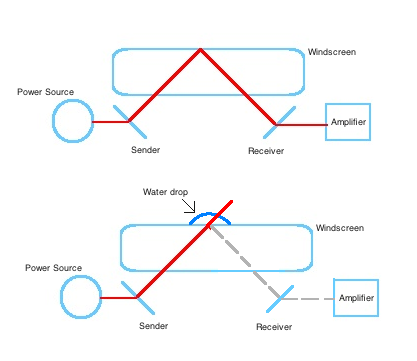Rain Sensors
- Basic Description
-
Automotive rain sensors detect rain falling on the windshield of a vehicle. Although rain sensors first appeared on automobiles 50 years ago [1], they have only recently begun to see widespread use. Most rain sensor implementations employ an infrared light that is beamed at a 45-degree angle onto the windshield from inside the car. If the glass is wet, less light makes it back to the sensor. The software in a rain-sensing system turns on the wipers when the amount of light reflected onto the sensor decreases to a preset level. The software sets the speed of the wipers based on how fast the moisture builds up between wipes. It can operate the wipers at any speed. The system adjusts the speed as often as necessary to match the rate of moisture accumulation.

Other rain sensors measure the capacitance between two metal plates. The presence of water droplets near the plates causes a change in the capacitance. Another type of rain sensor employs a piezoelectric vibrating element that responds to the frequencies produced by rain drops hitting the windshield.
- Manufacturers
-
Bosch, Casco, Hella,
Hydreon,
TRW,
Xenso
- For More Information
- [1] Rain Sensor, Wikipedia.
- [2] Rain-Sensing Wipers, Karim Nice, HowStuffWorks, Mar. 23, 2001.
- [3] 2008 Silverado RainSense Wipers, YouTube, Jan. 16, 2008.
- [4] Automatic Saab Windshield Wipers, YouTube, July 12, 2009.
- [5] Rain Tracker RT-50A (Rain Sensor with Auto Wiper Control), YouTube, Mar. 12, 2010.
- [6] Auto Rain Closing Windows on a Volkswagen, YouTube, Sep. 24, 2011.
- [7] BMW E39 Rain Sensor, YouTube, June 3, 2012.
- [8] Rain-Sensing Windshield Wipers, YouTube, May 5, 2014.
- [9] How a Rain Sensor for Automatic Windshield Wipers Works, YouTube, Apr. 23, 2015.
|

